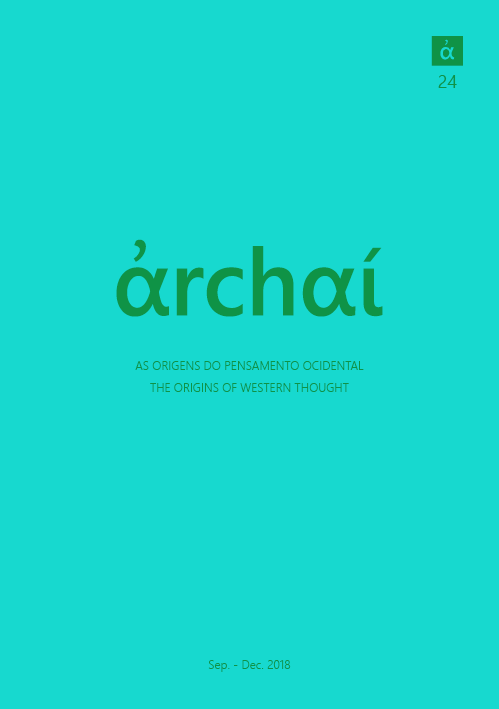The parts for the whole
parataxic mentality in Homer and the Old Testament
DOI:
https://doi.org/10.14195/1984-249X_24_5Keywords:
Homer, Old Testament, AnthropologyAbstract
This article aims to demonstrate the existence of a parataxic mentality both in Homeric works and in the Old Testament, establishing a parallel to show that the body, as a living organic unit, which is shown through its parts that express not only the whole but also the individual. Therefore, there is a possible relationship between what Giovanni Reale understood as the “parataxic mentality” of Homeric poems, and what Hans Walter Wolff indicates as the “stereometric-synthetic thinking” of the Old Testament. By attesting this relation and similarity between the mentalities of the Old Testament and the Homeric works, it’s shown not only the importance of a comparative study but also a renewal of both the anthropological grammar of these texts and the history of the anthropological concepts in Ancient Greece and even in the Judeo-Christian tradition.
Downloads
References
BREMMER, J. N. (1983). The Early Greek Concept of the Soul. Princeton, Princeton University Press.
CHEVITARESE, A. L. (2004). Fronteiras Culturais no Mediterrâneo antigo: gregos e judeus nos períodos Arcaico, Clássico e Helenístico. Politeia: Hist. e Soc. 4, nº 1, p. 69-82.
CLARKE, M. (1999). Flesh and Spirit in the Songs of Homer: A Study of Words and Myths. Oxford, Clarendon Press.
CULLEY, R. C. (1986). Oral Tradition and Biblical Studies. Oral Tradition 1, nº 1, p. 30-65.
FRIEDRICH, P. & REDFIELD, J. (1978). Speech as a Personality Symbol: The Case of Achilles. Language 54, nº 2, p. 263-288.
GASKIN, R. (1990). Do Homeric Heroes Make Real Decisions? The Classical Quarterly 40, nº 1, p. 1-15.
GORDON, C. H. (1955). Homer and Bible: the origin and character of East Mediterranean Literature. Hebrew Union College Annual 26, p. 43-108.
HAAG, H. (1961). Homer und das Alte Testament. Theologische Quartalschrift 141, p. 1-24.
JANOWSKI, B. (2013). Arguing with God: a theological anthropology of the Psalms. Translated by Armin Siedlecki. Louisville, Westminster John Knox Press.
HARRISON, E. L. (1960). Notes on Homeric Psychology. Phoenix 14, nº 2, p. 63-80.
KRAHMER, G. (1931). Figur und Raum in der Ägyptischen und Griechisch-Archaischen Kunst. Halle, Max Niemeyer.
LONG, A. A. (2015). Greek Models of Mind and Self. Cambridge, Harvard University Press.
LYS, D. (1966). The Israelite Soul according to the LXX. Vetus Testamentum 16, nº 2, p. 181-228.
MAIER, A. M.; FANTALKIN, A.; ZUKERMAN, A. (2009). The Earliest Greek Import in the Iron Age Levant: New evidence from Tell Es-Safi/Gath, Israel. Ancient West & East 8, p. 57-80.
MARCHADOUR, A. (1985). Morte e vida na Bíblia. São Paulo, Paulinas.
NIEHOFF, M. R. (2011). Jewish Exegesis and Homeric Scholarship in Alexandria. Cambridge, Cambridge University Press.
NOTOPOULOS, J. A. (1949). Parataxis in Homer: a new approach to homeric literary criticism. Transactions and Proceedings of the American Philological Association 80, p. 1-23.
OLIVEIRA, A. C. de. (2008). Considerações sobre a psykhé nos poemas homéricos. Gaia 8, p. 7-27.
REALE, G. (2002). Corpo, alma e saúde: o conceito de homem de Homero a Platão. Trad. Marcelo Perine. São Paulo, Paulus.
REDFIELD, J. M. (1975). Nature and Culture in the Iliad: The Tragedy of Hector. Chicago, University of Chicago Press.
ROBINSON, T. (2010). As origens da alma: os gregos e o conceito de alma de Homero a Aristóteles. São Paulo, Annablume.
RÖMER, T. (2015). The Hebrew Bible and Greek Philosophy and Mythology ”“ some case studies. Semitica 57, p. 185-203.
RUPPENTHAL NETO, W. (2016). O conceito de nefesh no Antigo Testamento. Vox Scripturae 24, nº 1, p. 31-53.
SANTOS, B. S. (1999). A imortalidade da alma no Fédon de Platão: coerência e legitimidade do argumento final. Porto Alegre, EDIPUCRS.
SEEBASS, H. (1998). × Ö¶×¤Ö¶×©× nepeš. In: BOTTERWECK, G. J.; RINGGREN, H.; FABRY, H.-J. Theological Dictionary of the Old Testament. Vol. IX. Grand Rapids, Eerdmans, p. 497-519.
SILVA, B. M. (2010). Thymós e psykhé nas obras homéricas. In: I Congresso Internacional de Religião, Mito e Magia no Mundo Antigo & IX Fórum de debates em História Antiga, Rio de Janeiro, p. 57-67.
SNELL, B. (2005). A cultura grega e as origens do pensamento europeu. São Paulo, Perspectiva.
STEAD, C. (1999). A filosofia na Antiguidade Cristã. São Paulo, Paulus.
SULLIVAN, S. D. (1988). Psychological Activity in Homer: A Study of Phrēn. Ottawa, Carleton University Press.
VERNANT, J.-P. (2008). Mito e Pensamento entre os Gregos: Estudos de psicologia histórica. Rio de Janeiro, Paz e Terra.
VON RAD, G. (1993). Wisdom in Israel. Harrisburg, Trinity Press International.
WALDBAUM, J. C. (1994). Early Greek Contacts with the Southern Levant, ca. 1000-600 B.C.: The Eastern Perspective. Bulletin of the American Schools of Oriental Research 293, p. 53-66.
WARDEN, J. (1971). ΨΥΧΗ in Homeric Death-Descriptions. Phoenix 25, nº 2, p. 95-103.
WILLIAMS, B. (1993). Shame and Necessity. Berkeley, University of California Press.
WOLFF, H. W. (2008). Antropologia do Antigo Testamento. São Paulo, Hagnos.
Downloads
Published
How to Cite
Issue
Section
License
Given the public access policy of the journal, the use of the published texts is free, with the obligation of recognizing the original authorship and the first publication in this journal. The authors of the published contributions are entirely and exclusively responsible for their contents.
1. The authors authorize the publication of the article in this journal.
2. The authors guarantee that the contribution is original, and take full responsibility for its content in case of impugnation by third parties.
3. The authors guarantee that the contribution is not under evaluation in another journal.
4. The authors keep the copyright and convey to the journal the right of first publication, the work being licensed under a Creative Commons Attribution License-BY.
5. The authors are allowed and stimulated to publicize and distribute their work on-line after the publication in the journal.
6. The authors of the approved works authorize the journal to distribute their content, after publication, for reproduction in content indexes, virtual libraries and similars.
7. The editors reserve the right to make adjustments to the text and to adequate the article to the editorial rules of the journal.



